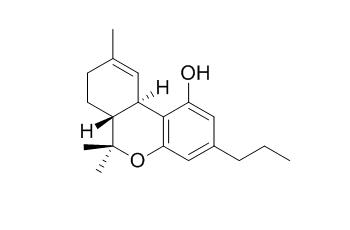Tetrahydrocannabivarin
Tetrahydrocannabivarin is a neutral cannabis receptor subtype (CB1) receptor antagonist, it can increases neural responding to rewarding and aversive stimuli, this effect profile suggests therapeutic activity in obesity, perhaps with a lowered risk of depressive side effects. Tetrahydrocannabivarin exhibits anticonvulsant effects in a piriform cortical brain slice model of epileptiform activity.
Inquire / Order:
manager@chemfaces.com
Technical Inquiries:
service@chemfaces.com
Tel:
+86-27-84237783
Fax:
+86-27-84254680
Address:
1 Building, No. 83, CheCheng Rd., Wuhan Economic and Technological Development Zone, Wuhan, Hubei 430056, PRC
Providing storage is as stated on the product vial and the vial is kept tightly sealed, the product can be stored for up to
24 months(2-8C).
Wherever possible, you should prepare and use solutions on the same day. However, if you need to make up stock solutions in advance, we recommend that you store the solution as aliquots in tightly sealed vials at -20C. Generally, these will be useable for up to two weeks. Before use, and prior to opening the vial we recommend that you allow your product to equilibrate to room temperature for at least 1 hour.
Need more advice on solubility, usage and handling? Please email to: service@chemfaces.com
The packaging of the product may have turned upside down during transportation, resulting in the natural compounds adhering to the neck or cap of the vial. take the vial out of its packaging and gently shake to let the compounds fall to the bottom of the vial. for liquid products, centrifuge at 200-500 RPM to gather the liquid at the bottom of the vial. try to avoid loss or contamination during handling.
Korean J. Agricultural Science2024, 51(3).
Expert Opin Ther Targets.2024, :1-11.
Universite de Bordeaux2017, 2017BORD0867
Mol Cancer Ther.2024, 1535-7163.
Eur J Pharmacol.2023, 960:176121.
Phytomedicine.2024, 128:155527.
Brain Res Bull.2024, 218:111103.
Int J Mol Sci.2021, 22(19):10405.
Int J Mol Sci.2019, 20(3):E651
Pharmaceuticals (Basel).2021, 14(7):633.
Related and Featured Products
Biotechnology Letters, 2011, 33(12):2503-2508.
Molecular analysis of genetic fidelity in Cannabis sativa L. plants grown from synthetic (encapsulated) seeds following in vitro storage.[Pubmed:
21805186]
The increasing utilization of synthetic (encapsulated) seeds for germplasm conservation and propagation necessitates the assessment of genetic stability of conserved propagules following their plantlet conversion.
METHODS AND RESULTS:
We have assessed the genetic stability of synthetic seeds of Cannabis sativa L. during in vitro multiplication and storage for 6 months at different growth conditions using inter simple sequence repeat (ISSR) DNA fingerprinting. Molecular analysis of randomly selected plants from each batch was conducted using 14 ISSR markers. Of the 14 primers tested, nine produced 40 distinct and reproducible bands.
All the ISSR profiles from in vitro stored plants were monomorphic and comparable to the mother plant which confirms the genetic stability among the clones.
CONCLUSIONS:
GC analysis of six major cannabinoids [Δ(9)-tetrahydrocannabinol, Tetrahydrocannabivarin, cannabidiol, cannabichromene, cannabigerol and cannabinol] showed homogeneity in the re-grown clones and the mother plant with insignificant differences in cannabinoids content, thereby confirming the stability of plants derived from synthetic seeds following 6 months storage.
Proceedings of the British Pharmacological Society, 2006.
Tetrahydrocannabivarin exhibits anticonvulsant effects in a piriform cortical brain slice model of epileptiform activity[Reference:
WebLink]
Tetrahydrocannabivarin exhibits anticonvulsant effects in a piriform cortical brain slice model of epileptiform activity.
Int J Neuropsychopharmacol. 2015 Apr; 18(6): pyu094.
Neural Effects of Cannabinoid CB1 Neutral Antagonist Tetrahydrocannabivarin on Food Reward and Aversion in Healthy Volunteers[Pubmed:
25542687]
Disturbances in the regulation of reward and aversion in the brain may underlie disorders such as obesity and eating disorders.
We previously showed that the cannabis receptor subtype (CB1) inverse agonist rimonabant, an antiobesity drug withdrawn due to depressogenic side effects, diminished neural reward responses yet increased aversive responses (Horder et al., 2010). Unlike rimonabant, Tetrahydrocannabivarin is a neutral CB1 receptor antagonist (Pertwee, 2005) and may therefore produce different modulations of the neural reward system.
METHODS AND RESULTS:
We hypothesized that Tetrahydrocannabivarin would, unlike rimonabant, leave intact neural reward responses but augment aversive responses. There were no significant differences between groups in subjective ratings. However, Tetrahydrocannabivarin increased responses to chocolate stimuli in the midbrain, anterior cingulate cortex, caudate, and putamen. Tetrahydrocannabivarin also increased responses to aversive stimuli in the amygdala, insula, mid orbitofrontal cortex, caudate, and putamen.
CONCLUSIONS:
Our findings are the first to show that treatment with the CB1 neutral antagonist Tetrahydrocannabivarin increases neural responding to rewarding and aversive stimuli. This effect profile suggests therapeutic activity in obesity, perhaps with a lowered risk of depressive side effects.



